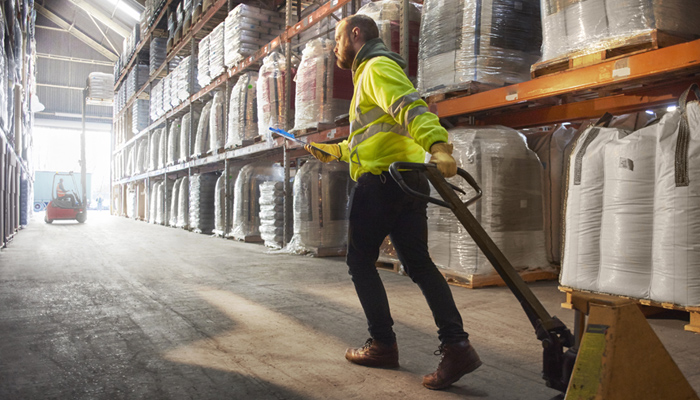Rightsize Your Insurance
9 out of 10 buildings in the United Kingdom are insured for the wrong amount*. When you insure a building, it is your responsibility to decide how much to insure it for. Your broker or insurer cannot tell you this amount.
9 out of 10 buildings in the United Kingdom are insured for the wrong amount*.
When you insure a building, it is your responsibility to decide how much to insure it for. Your broker or insurer cannot tell you this amount.
You need to insure for the cost to rebuild the property from scratch; this will also need to include additional costs like fees, demolition costs and ground clearance etc.
It is important to ensure your building is insured for the correct amount, if you are over insured, you may be paying too much for your insurance, and if you are underinsured, it could result in devastating consequences for you and your business should you need to make a claim.
*Data derived from 14,713 Rebuild Cost Assessments completed between Sep 2020 and Aug 2021.
What is underinsurance?
Underinsurance is when the cover you have purchased is not enough to meet your business requirements in the event of a claim. Insuring assets for incorrect values or setting cover limits too low is likely to result in underinsurance.
One of the most important things to consider when taking out an insurance policy is just how much cover you actually need. If your cover isn’t adequate and you need to make a claim, you could end up paying a lot more than you anticipated.
80% of properties are underinsured*, and the estimated underinsurance total for all UK commercial properties is £340 billion**. So, it is crucial to make sure you are accurately covered.
It isn’t just buildings being underinsured that can reduce the payout in the event of a claim, your reported turnover matters too. If the turnover is not correctly reported then the accurate amount will not be paid out in a business interruption claim. This could leave you out of pocket and affect your ability to get back to normal quickly.
Underinsurance or overinsurance?

| Whilst 80% of commercial properties in the UK are underinsured, an estimated 14% of properties are overinsured. If this is you, you are paying more than you need to for your insurance | On average, underinsured buildings are covered for 68% of the amount they should be, while overinsured buildings are covered on average for 126% of the correct amount* |
*Data derived from 14,713 rebuild cost assessments completed between Sep 2020 and Aug 2021
The average clause
Insurance policies have clauses and conditions that come with the cover. When it comes to insuring your building, there is one clause in particular that is important to understand as it can significantly affect the amount paid out if you claim. This clause is known as the condition of average or the average clause.
The ‘average’ clause is applied to the majority of insurance policies whereby, in the event of underinsurance, the claim paid out by the insurer is restricted to the same proportion as the value of the underinsurance (the proportion of what the sum insured is in relation to the total value of the insured item). Essentially, if you haven’t paid the correct premium for your property, the claim paid will be reduced. In the worst-case scenario, some insurers may not pay anything out in claims at all.
The formula used to work out how much is paid out under the average clause is:
| Payout = Claim x Sum Insured Current Value |
Payout: Claim: Sum Insured: Current Value: |
the amount paid by the policy the amount claimed against the policy after a loss the maximum amount to be paid out by the policy the value the policy should be insured for |
Underinsurance occurs when the Sum Insured is less than the Current Value - If the building should be covered for £1,000,000 but is only insured for £500,000, then the amount payable will be reduced by 50% because the building is underinsured by 50%. This means if you make a claim for only £10,000, you may think you’ll be covered as you are insured for £500,000, but if you are 50% underinsured, the insurance company will only pay 50% out so you would only receive a maximum of £5,000.
Towergate's underinsurance jargon buster
Average:
A clause in insurance policies which calculates a payout against a claim where the policy undervalues the sum insured. In the event of partial loss, the amount paid against a claim will be the same proportion as the value of the underinsurance.
Contents Insurance:
Covers the items in the property which are not fitted to the main structure of the building such as equipment, appliances, furniture, and other items of value. If you were to turn your building upside down, anything that fell out would be classed as ‘contents’.
Buildings Insurance:
Buildings insurance covers the fabric of the actual building and the cost of damage to the structure of your property. This includes the roof, walls, ceilings, floors, doors and windows. Outdoor structures, along with the cost of debris removal and site access are also included.
Employers Liability Insurance:
This cover protects employees from loss or injury while carrying out work for you. So, if you have any full or part time staff, volunteers, interns, contracted or freelance workers, it’s your responsibility to have the correct cover in place.
Business Interruption:
Covers lost income while a business is out of commission or you are unable to trade. It also includes the costs of repair necessary to get your business back up and running. An estimated 43% of business interruption insurance policies are thought to be underinsured by more than 50% (according to a Chartered Institute of Loss Adjusters report*), so it is crucial to make sure you are covered for all eventualities.
Public Liability Insurance:
To cover you should you be sued by a member of the public if they are injured, or their belongings are damaged as a result of your negligence.
| Buildings and contents insurance, business interruption, and employers and public liability, are common areas where underinsurance can be found |
*Source: ‘Zurich Insider’, September 2017 edition
Are you underinsured?
| It’s listed, made of stone or other nonconventional material. | It was constructed prior to 1920. | It has not had a professional valuation within the last three years. |
| Your building has recently been altered or extended or is in an unusual location, perhaps with restricted access. | It has ‘ecofriendly’ features. | The value of your property is based on developer’s costs, which are often much lower than one-off rebuilding costs. |
| You only cover an indemnity period of 12 months on your business interruption cover. | You haven’t factored in costs for outbuildings, car parks, driveways, gates, fences, boundary walls, paving or lighting. | You are carrying more stock (even if temporary/seasonal) than you were when you took out your policy. |
| You have purchased additional equipment, tools or machinery and have not advised your broker/insurer. | You haven’t factored in costs such as professional fees, site clearance or access. |
| Your property is finished to a significantly higher standard than normal. | You are now VAT registered. |
Tips to avoid underinsurance
Here are some tips on making sure you avoid underinsurance when taking out a policy:
Get an expert valuation.
Don’t use general market prices.
Take care when using online calculators to get the value of your property – some of these may be inaccurate and may not include unique features or existing property damage which could impact the valuation.
Check the VAT status. Some aspects of a building’s reinstatement might attract
VAT while others might not, and the position can vary depending on each organisation’s tax arrangements.
Average clause. Understand how the ‘condition of average’ clause applies typically included in property insurance policy wordings.
Contents valuation. Don’t forget that contents should be insured for their new replacement value and the value should be sufficient to cover all of your contents. You must not omit items and insure everything: while small items may seem insignificant when considering values, it is important to accurately value and include them when making a decision. These can add up quickly, and it’s worth keeping an up-to-date inventory of all the items you wish to insure to make your valuation go as smoothly as possible. We suggest you make a list room by room.
Stock insurance. When you hold stock, this should be insured for the cost of replacement to you, not the price you sell at. Many businesses are seasonal. You must take account of the maximum stock levels in your property at any one time, and not the value that may be present when arranging your insurance cover.
Review values at risk regularly. We recommend that buildings are professionally re-valued for rebuilding costs at least every three years. Property values fluctuate and so it may happen that the insurance you took out five years ago may now not be sufficient cover.
Business changes. You should also consider adjusting your policy when you make changes to the business. If you get new machinery or technology in the building, that can have a significant effect on the level of cover you will require. Discuss the changes with your broker before you go ahead with them, so you aren’t caught by surprise later.
Ensure your business interruption is adequate
Your business interruption insurance not only needs to cover your ongoing costs and net profit (even though you may not be trading due to the insured damage), but also take into account the forecasting of how your profits and revenue are planned to rise during the period you are unable to trade and while your business is recovering, so your sum insured is adequate to cover future plans and growth as well.
In selecting your indemnity period, this must be of sufficient time to enable your turnover to recover to at least the same level as you were at the time the incident occurred.
It is also important to remember how long you will need the cover for. Think every year about how your business has changed and how long it would take to get your property back to how it was running prior to a claim.
Underinsurance risks often relate to replacement of property, where the costs relate not only to the rebuilding of the property itself but also the consequential business interruption while the building is being replaced. Remember to think about:
- Costs for planning, permissions, site clearance, digging, construction, etc
- The fact you will have to pay for alternative premises in the meantime
- How long it will take for your turnover to recover once you have reopened
- Lease, rent, rates and facilities outgoings still in your name
- Insuring the property for the rebuild costs, not the market value
- Any extensions, changes or extra buildings which could affect your sums insured
- If you have rented a property, any tenants’ improvements you have made for which you
are responsible
What is impacting underinsurance
COVID – Covid-19 has had a sudden impact on operations. Businesses have been forced to adapt and reduce expenses (even if only in the short-term) leading to large scale underinsurance. The pandemic has also led to loss of income to businesses. Many were forced to close, downsize, or cut costs during lockdowns. When it comes to cutting costs, insurance budgets tend to decrease. This combined with the uncertainty and insecurity around operations makes it challenging to assess the amount of insurance required, potential stockpiling and if contents are adequately insured.
If a business didn’t perform as well during the pandemic as it has done previously, it may have reduced its sums insured in line with current performance. However, the economy is predicted to grow again, which, in turn is likely to lead to an increase in performance. Businesses will need to ensure its sums insured reflects this, otherwise there could be a shortfall when the time comes for them to claim.
Rising reconstruction costs – A sustained rise in construction costs this year is increasing the likelihood of significant underinsurance of buildings in the UK, which means many commercial buildings are unprotected in the event of a loss or damage. According to the Builders Merchants Federation (BMF), prices have risen by between 10% and 15% for products and materials this year. However, some products, such as timber, have seen prices go up by 50% and by as much as 100% for oriented strand board (OSB) and other sheet materials, which are all key building components.
Between July 2020 and July 2021, the cost of materials rose by 20%, according to the Office for National Statistics (ONS). It is unlikely that annual indexation will have allowed for these increases and, where a building sum insured is already on the low side, rising costs will be increasing the potential for underinsurance.
Brexit – As well as pent up demands following Covid lockdowns and the restarting of postponed building projects, there is also the impact of Brexit on imports from the EU. The loss of around 1.5 million foreign workers throughout 2020 and 2021, many from construction, together with increased demand in other countries for construction materials, such as high Chinese demand for steel and extended lead times for virtually all materials, have combined to create a perfect storm around rebuilding costs.
Underinsurance case study
In 2018, a care home caught fire due to a short in the fuse box. Thankfully there were no injuries, but the fire caused a substantial amount of damage to the premises. This property was underinsured by 67%, therefore, the amount paid out for the loss was reduced by 67%. Due to the deficit, the business owner was unable to reinstate the premises due to the significant shortfall in the actual rebuild costs of 96%. As a result, the care home was forced to close, and 39 employees were made redundant.
This scenario could easily happen to any business – 73% of our customers alone have indicators that show underinsurance*. Underinsuring your business would lead to a reduced payout in the event of a claim which in turn could have devastating consequences on your business.
*Percentage is based on desk top indicators carried out in 2020 by specialist surveyors CPA Surveying Services Limited.
How can Towergate help ensure that you are adequately covered in the event you need to claim?
We want to help you ensure you are adequately covered in the event you need to claim. It is our duty as your insurance broker to make sure you are aware of the risks of underinsurance and understand how you could be paying too much for your insurance if you are overinsured.
If your building is currently underinsured, your policy premium may increase to insure it for the correct amount. However, compared to losing tens of thousands of pounds and the stress of potentially going out of business should you need to make a claim, it is worth ensuring your property is insured for the correct amount.
Getting your property valued on a regular basis is essential to ensure your property is adequately insured
| 1 | FREE | A simple online desktop valuation tool that will give you a red, amber, green indication of the likelihood of underinsurance. |
| 2 | ENHANCED | A new affordable enhanced desktop valuation service. For a small fee, you will receive a recommendation as to what the property should be insured for. |
| 3 | COST ON APPLICATION | A full on-site survey and report by a RICS (Royal Institution of Chartered Surveyors), regulated surveyor. |
The process starts with a free desktop review which will give an indication of whether the building is under, over or adequately insured.
After the free valuation review, you can pay a small fee to have an enhanced desktop survey. This will give you a report of how much you should insure your building for.
If the enhanced desktop review indicates a level of underinsurance, then a full on-site survey is strongly recommended to ensure you are not exposed in the event of a claim relating to serious building damage such as fire or flood. It may also indicate a level of over insurance where you may be paying too much.
The fee for carrying the survey out will be agreed up front and a site visit arranged. The site visit will provide you with an accurate rebuild cost and enable you to update your sums insured as necessary. The cost of the enhanced desktop review is discounted depending on the cost of the full survey, should you choose to go ahead with it.
Find out more about ensuring your property is adequately insured
Or, if you want to speak to one of our specialist advisers about underinsurance, please call us on: 01438 739 739 or email us at: caredivision@towergate.co.uk.
Care and business insurance from Towergate
Make sure you speak to us to carefully assess your needs so you can avoid underinsurance.
Visit our business insurance hub, call 0344 892 1664 or email us at sm-newbusiness.enquiries@towergate.co.ukfor SME, tradesman or small business insurance, or our care and medical insurance hub, 01438 739 734 or medical@towergate.co.uk to learn more about our care insurance products.
About the author
 Alison Wild BCom (Hons), FMAAT, MATT, Taxation Technician is a highly respected industry professional who has been working with and advising SMEs in areas including tax, pensions, insurance and marketing for over 25 years. She is a member of the Association of Accounting Technicians (AAT) and Association of Tax Technicians (ATT) and also has over 20 years' experience as a residential landlord.
Alison Wild BCom (Hons), FMAAT, MATT, Taxation Technician is a highly respected industry professional who has been working with and advising SMEs in areas including tax, pensions, insurance and marketing for over 25 years. She is a member of the Association of Accounting Technicians (AAT) and Association of Tax Technicians (ATT) and also has over 20 years' experience as a residential landlord.
Date: May 09, 2022
Category: Commercial Property















